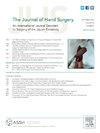Evaluation of Test–Retest Reliability for the Patient-Reported Outcomes Measurement Information System Upper Extremity and Pain Interference Computer Adaptive Tests in a Hand Surgery Population
IF 2.1
2区 医学
Q2 ORTHOPEDICS
引用次数: 0
Abstract
Purpose
Utilization of the Patient-Reported Outcomes Measurement Information System (PROMIS) upper extremity (UE) and pain interference (PI) computer adaptive tests (CAT) has grown in the hand surgery literature. However, these instruments were derived using data from a general population rather than cohorts with UE pathology. As such, our primary purpose was to evaluate the test-retest reliability of the UE and PI CATs in a sample of hand surgery patients.
Methods
At a tertiary academic center, we recruited adult (≥18 years) orthopedic hand surgery patients who completed the PROMIS UE and PI CAT 1–7 days prior to their office appointment, plus a subsequent response to both instruments in clinic. Patients were included only if their upper extremity symptoms were stable between questionnaires, as assessed by an anchor question (eg, no change in scores is expected). Intraclass correlation coefficients (ICCs) were used to assess test–retest reliability. Bland–Altman Plots were created to visualize the proportion of patients whose scores differed by a value greater than the minimally clinically important difference for both instruments (4.1 for UE CAT, 4.3 for PI CAT).
Results
The 88 included patients had a mean age of 54 ± 18 years, and 56% (56/88) were women. There was a mean of 4 ± 2 days between surveys. The UE CAT demonstrated an ICC of 0.87 (95% confidence intervals [CI], 0.80–0.91), consistent with “good” to “excellent” reliability. The PI CAT ICC was 0.84 (95% CI, 0.76–0.89), consistent with “good” reliability. However, 34% (30/88) and 23% (20/88) of patients had UE CAT and PI CAT score differences that exceeded minimally clinically important difference thresholds.
Conclusions
For a hand surgery cohort (population level), the UE CAT demonstrated “good” to “excellent” test–retest reliability, and the PI CAT demonstrated “good” reliability. However at the patient level, score differences were clinically relevant in approximately one of three patients for UE CAT and one of four patients for the PI CAT. We conclude that these instruments are reliable at the population level, but should not be used at the level of individual hand surgery patients.
Type of study/level of evidence
Therapeutic II.
手外科患者报告结果测量信息系统上肢和疼痛干扰计算机自适应测试的重测信度评价
目的:患者报告结果测量信息系统(PROMIS)上肢(UE)和疼痛干扰(PI)计算机自适应测试(CAT)的使用在手外科文献中越来越多。然而,这些工具使用的数据来自一般人群,而不是UE病理队列。因此,我们的主要目的是评估UE和PI cat在手部手术患者样本中的重测可靠性。方法:在一个三级学术中心,我们招募了成年(≥18岁)矫形手部手术患者,这些患者在他们的办公室预约前1-7天完成了PROMIS UE和PI CAT,以及随后在临床中对这两种器械的反应。只有通过锚定问题评估上肢症状在两次问卷之间保持稳定的患者才被纳入研究(例如,预计评分不会发生变化)。用类内相关系数(ICCs)评估重测信度。创建Bland-Altman图来可视化两种仪器评分差异大于最小临床重要差异的患者比例(UE CAT为4.1,PI CAT为4.3)。结果:88例患者平均年龄54±18岁,56%(56/88)为女性。调查间隔平均为4±2天。UE CAT显示ICC为0.87(95%置信区间[CI], 0.80-0.91),符合“良好”到“优秀”的信度。PI CAT ICC为0.84 (95% CI, 0.76-0.89),符合“良好”信度。然而,34%(30/88)和23%(20/88)的患者UE CAT和PI CAT评分差异超过了最低临床重要差异阈值。结论:对于手外科队列(人群水平),UE CAT表现出“良好”到“优秀”的重测信度,PI CAT表现出“良好”的信度。然而,在患者水平上,大约三分之一的UE CAT患者和四分之一的PI CAT患者的评分差异具有临床相关性。我们的结论是,这些仪器在人群水平上是可靠的,但不应用于手部手术患者的个体水平。研究类型/证据水平:治疗性II。
本文章由计算机程序翻译,如有差异,请以英文原文为准。
求助全文
约1分钟内获得全文
求助全文
来源期刊
CiteScore
3.20
自引率
10.50%
发文量
402
审稿时长
12 weeks
期刊介绍:
The Journal of Hand Surgery publishes original, peer-reviewed articles related to the pathophysiology, diagnosis, and treatment of diseases and conditions of the upper extremity; these include both clinical and basic science studies, along with case reports. Special features include Review Articles (including Current Concepts and The Hand Surgery Landscape), Reviews of Books and Media, and Letters to the Editor.

 求助内容:
求助内容: 应助结果提醒方式:
应助结果提醒方式:


